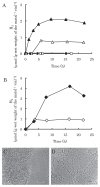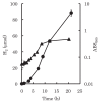Production and consumption of hydrogen in hot spring microbial mats dominated by a filamentous anoxygenic photosynthetic bacterium
- PMID: 22446313
- PMCID: PMC4036054
- DOI: 10.1264/jsme2.me11348
Production and consumption of hydrogen in hot spring microbial mats dominated by a filamentous anoxygenic photosynthetic bacterium
Abstract
Microbial mats containing the filamentous anoxygenic photosynthetic bacterium Chloroflexus aggregans develop at Nakabusa hot spring in Japan. Under anaerobic conditions in these mats, interspecies interaction between sulfate-reducing bacteria as sulfide producers and C. aggregans as a sulfide consumer has been proposed to constitute a sulfur cycle; however, the electron donor utilized for microbial sulfide production at Nakabusa remains to be identified. In order to determine this electron donor and its source, ex situ experimental incubation of mats was explored. In the presence of molybdate, which inhibits biological sulfate reduction, hydrogen gas was released from mat samples, indicating that this hydrogen is normally consumed as an electron donor by sulfate-reducing bacteria. Hydrogen production decreased under illumination, indicating that C. aggregans also functions as a hydrogen consumer. Small amounts of hydrogen may have also been consumed for sulfur reduction. Clone library analysis of 16S rRNA genes amplified from the mats indicated the existence of several species of hydrogen-producing fermentative bacteria. Among them, the most dominant fermenter, Fervidobacterium sp., was successfully isolated. This isolate produced hydrogen through the fermentation of organic carbon. Dispersion of microbial cells in the mats resulted in hydrogen production without the addition of molybdate, suggesting that simultaneous production and consumption of hydrogen in the mats requires dense packing of cells. We propose a cyclic electron flow within the microbial mats, i.e., electron flow occurs through three elements: S (elemental sulfur, sulfide, sulfate), C (carbon dioxide, organic carbon) and H (di-hydrogen, protons).
Figures




References
-
- Aguiar P, Beveridge TJ, Reysenbach A.-L. Sulfurihydrogenibium azorense, sp. nov., a thermophilic hydrogen-oxidizing microaerophile from terrestrial hot springs in the Azores. Int J Syst Bacteriol. 2004;54:33–39. - PubMed
-
- Frigaard N.-U, Bryant DA. Seeing green bacteria in a new light: genomics-enabled studies of the photosynthetic apparatus in green sulfur bacteria and filamentous anoxygenic phototrophic bacteria. Arch Microbiol. 2004;182:265–276. - PubMed
-
- Grègoire P, Fardeau M.-L, Joseph M, et al. Isolation and characterization of Thermanaerothrix daxensis gen. nov., sp. nov., a thermophilic anaerobic bacterium pertaining to the phylum “Chloroflexi”, isolated from a deep hot aquifer in the Aquitaine Basin. Syst Appl Microbiol. 2011;34:494–497. - PubMed
Publication types
MeSH terms
Substances
Associated data
- Actions
- Actions
- Actions
- Actions
- Actions
- Actions
- Actions
- Actions
- Actions
- Actions
- Actions
- Actions
- Actions
- Actions
- Actions
- Actions
- Actions
- Actions
- Actions
- Actions
LinkOut - more resources
Full Text Sources
Molecular Biology Databases

